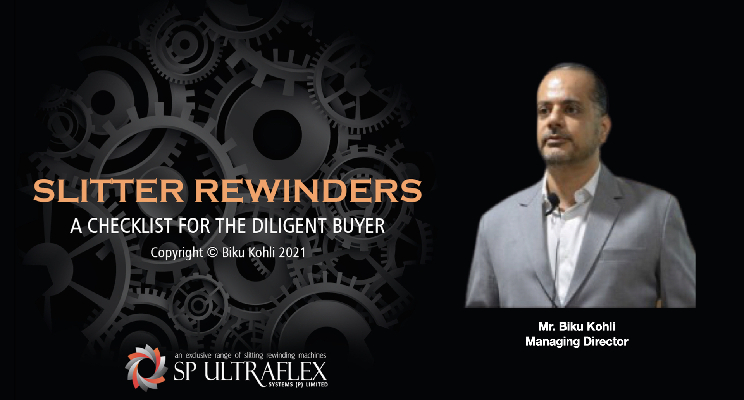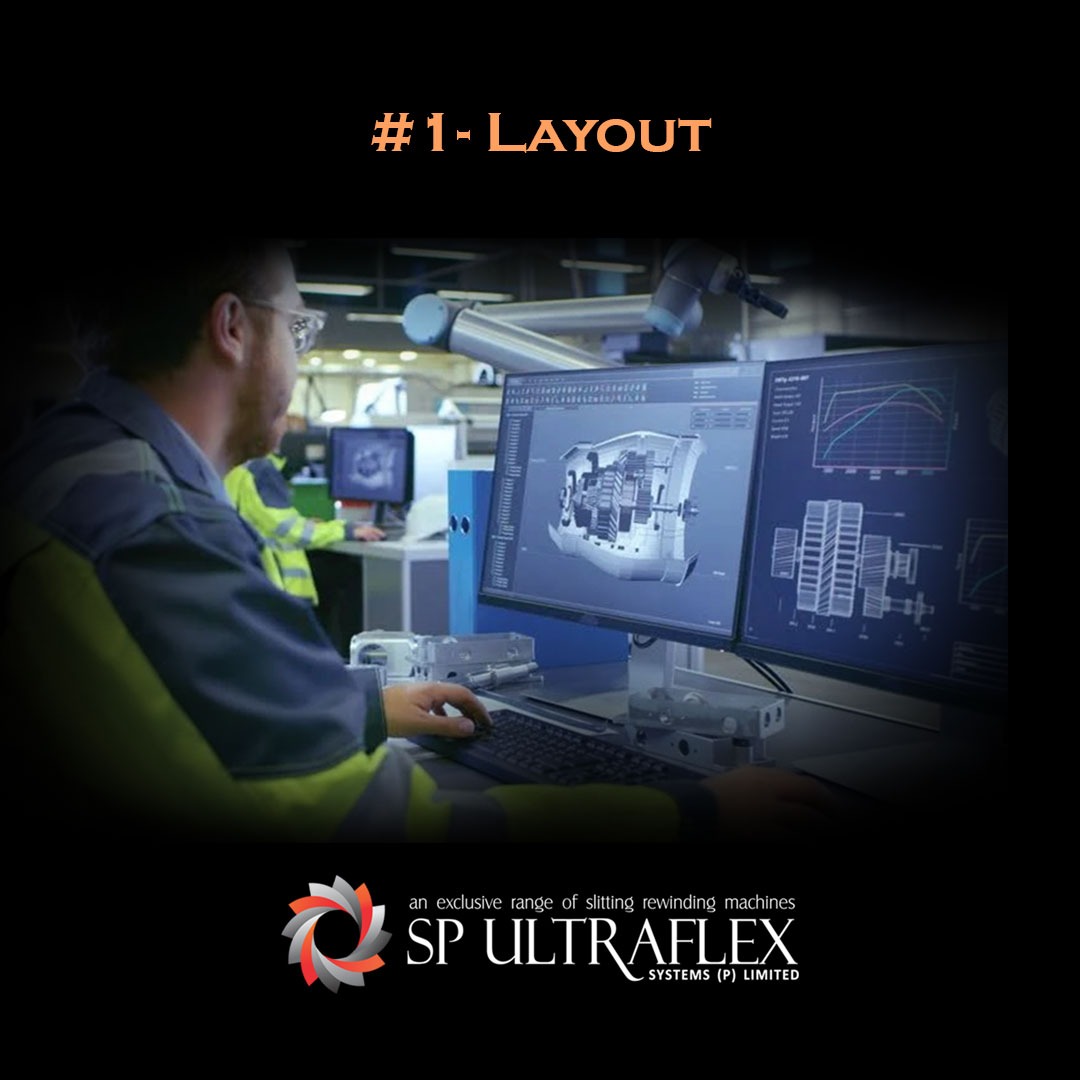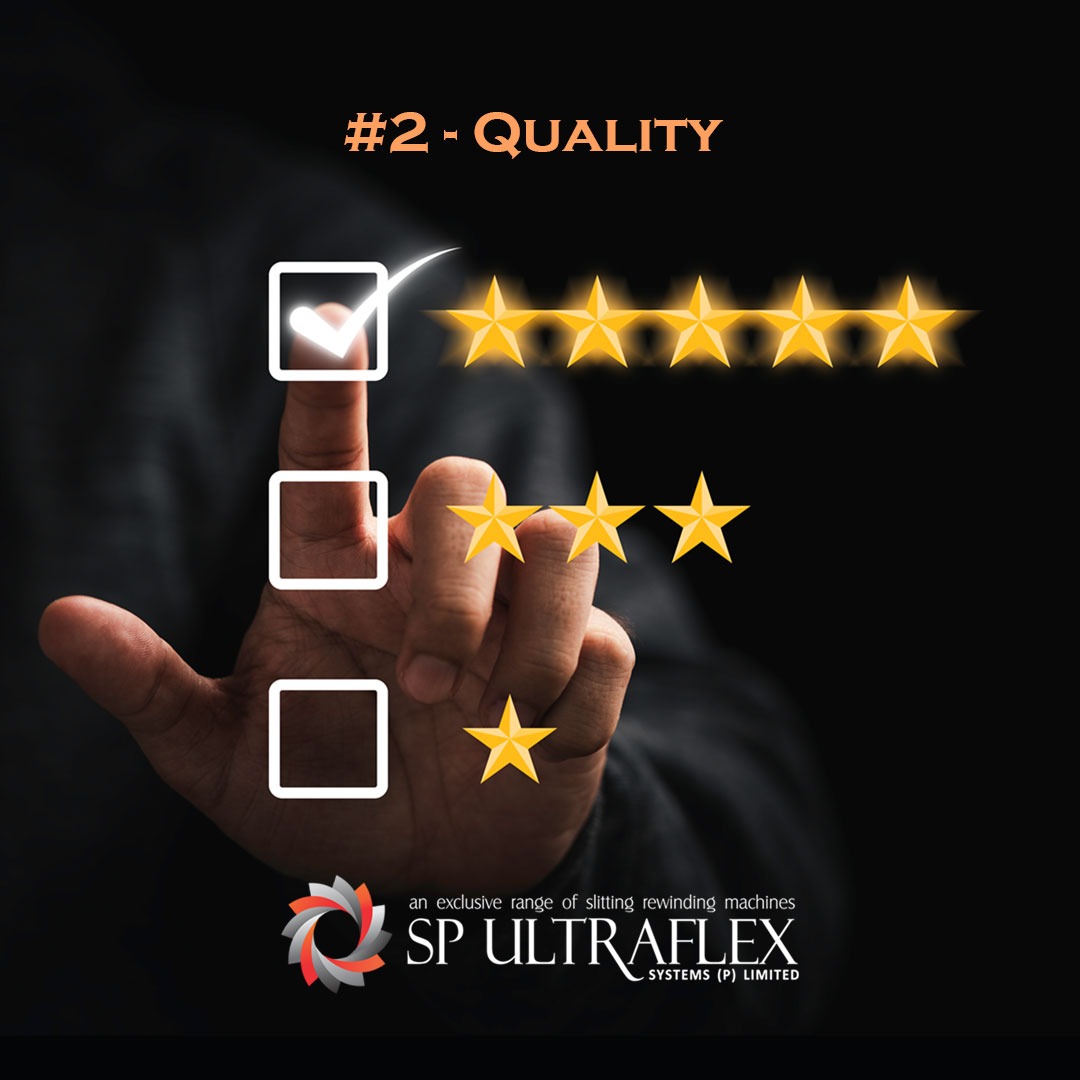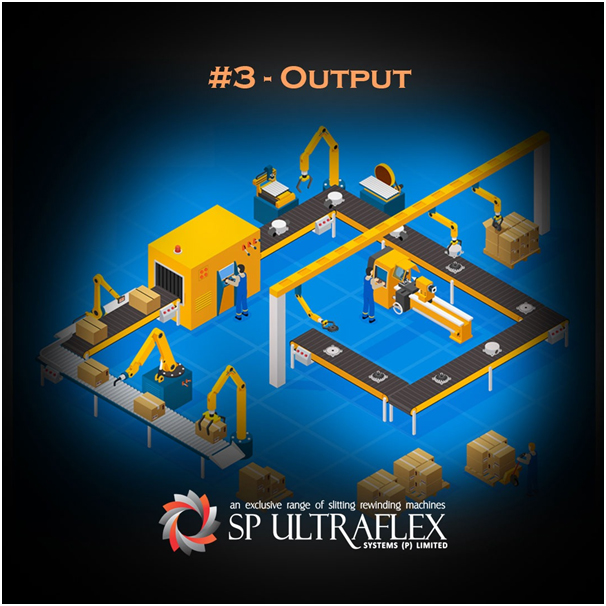
Blog


Slitter Rewinders- A Checklist for the Diligent Buyer
Introduction
Slitting and Rewinding is the final process before finished reels, after a series of converting operations on flexible packaging material are shipped to the customer.
As such, the performance of these machines has a direct bearing on the quality and visual appeal of the finished reels which is the proverbial “first impression” that a customer gets.
Being the last in a series of converting processes including co-extrusion, printing, inspection and lamination, any interruption during the slitting operation would result in the pile up of expensive inventory into which all the material and nearly all the process costs have been added.
The slitting process therefore is a critical one, both from the perspective of quality and throughput.
And no, the slitting process and therefore, the technology required to support this process is by no means less demanding than printing and lamination operations. As a matter of fact, there are certain challenges inherent to Slitter Rewinders which test the design and manufacturing faculties of the manufacturer to an even greater extent.
What are these challenges?
As the co-founder of a company that has focused exclusively on Slitter Rewinders for the past two decades, it is refreshing to see buyers in recent years exercising the same, if not more due diligence while selecting Slitter Rewinders as they have been doing in case of co-extrusion, printing, and lamination equipment.
This article is dedicated to listing down the important criteria that a buyer of Slitting and Rewinding machines should keep in mind while zeroing in on the equipment.
#1- Layout

Converting Slitter Rewinders are available either in compact versions, where the unwind section is integrated with the rest of the machine, or with an unwind that stands alone and is connected to the main machine either by an overhead bridge or an underpass platform. While compact machines have a smaller footprint and an understandably lower price tag attached to them, machines with stand-alone unwinds are clear winners when it comes to safety and visibility, access to key areas and the possibility to accommodate in line processes and bigger reel diameters.
Staying on the subject of hygiene, machines that have discarded traditional hydraulic mechanisms in favor of electric power for motion control are preferred by the above sectors. Apart from providing a more hygienic environment, a machine devoid of hydraulics provides a safer operating environment where maintenance requirements, if any, are an exception rather than the rule as is the case with hydraulics. A typical example here would be the floor-lift mechanism for the unwind reel in which case the traditional hydraulic mechanism is fast giving way to an electro-mechanical construction which apart achieving its prime objective of eliminating hydraulics, is also more operator friendly owing to its linear trajectory in the vertical plane.
#2 – Quality

It cannot be emphasized enough how important the quality aspect is on Slitter Rewinders. It would not be an exaggeration to state that when your supplied finished reel unwinds on the packaging machine of the brand owner, so does the image of your company.
Key quality parameters on converting Slitters include cutting accuracy/finish, winding accuracy/finish, reel tightness and residual static levels. The importance attached to each parameter would depend on the application, with some special applications also requiring additional criteria for smooth and unconditional acceptance by the customer.
There are many design considerations and features responsible for achieving each quality parameter and as such, the more stringent the quality standards of your customer, the more is the need for a quality machine from a reputed manufacturer.
#3- Output

“Traditional converting Slitters are able to run at top speed for a small fraction of the total time, making them inherently inefficient.”
The output of a converting Slitter depends on-
Like any converting machine, a Slitter Rewinder with a higher speed would yield a higher output. However, the relationship between speed and output here is not nearly as pro-rata as is the case with printing and lamination machines. Reason? Traditional converting Slitters are able to run at top speed for a small fraction of the total time, making them inherently inefficient. The majority of the time is accounted for by ramping up and down, reel changeovers and job changeovers. Therefore, any initiative to increase the output would be far from rewarding if they do not also include these areas.
Given the shorter job length in the slitting operation, ramp times need to be kept at minimal levels to maximize the time for which the machine runs at full rated speed. Reducing ramp times requires faster response from the motors in order to maintain web tension levels. This in turn requires better drives and control systems that are cut to the task.
For any length of time, Rewind Changeover Time = Changeover Frequency x Changeover Cycle Time. As compared to other converting machines, Rewind Changeover Times consume by far the maximum time on converting Slitter Rewinders, when viewed as a percentage of the total time. Why? First, the Changeover Frequency is much higher due to shorter reel lengths and higher speeds. Second is the need to changeover not one but multiple coils, which increases the Changeover Cycle Time. Dual Turret Slitter Rewinders are able to minimize Rewind Changeover Times by using two pairs of rewind shafts mounted on their respective turrets. On these machines, activities related to rewind changeover such as finished reels taping and ejection followed by fresh core taping and positioning are carried out on the free pair of shafts even as the machine continues to slit and rewind on the engaged pair of shafts. Apart from reducing the changeover time, this parallel mode of operation also results in the changeover cycle time for typical jobs being fixed, thereby introducing an element of uniformity in operator efficiency and making output levels repeatable and more predictable. From the above explanation of dual turret technology, it is obvious that the difference in output levels between Duplex and Dual Turret Slitters would be more when the reel lengths are shorter and/or speeds are higher (thereby increasing the Changeover Frequency) and/or the number of coils are higher (thereby increasing the Changeover Cycle Time). Any reputed manufacturer would be happy to share a productivity comparison between their Duplex and Dual Turret options for your specific job mix, thereby providing you a sound basis to make the differential price/benefit analysis and take a call accordingly.
Unwind changeovers are less frequent and hence less significant when it comes to output levels. Features to reduce unwind changeover time include shaftless unwinds, splice tables, web clamps and integrated floor lifts.
Job changeovers in converting Slitters are essentially about aligning the unwind, cutting and rewind sections to a new package design and as such, entail manual set-up activities in these three sections. More advanced machines are equipped with servo positioning mechanisms- either laser beams or pick and place type, to facilitate positioning of the unwind guide, cutters and rewind cores. Since this level of automation comes at a substantial cost, one would do well to carry out a cost-benefit analysis. Automatic job set-up is usually found to be feasible when the frequency of job change, number of coils and/or the cost attached to set up wastage (due to operator error) is reasonably high.
One can ill afford a bottle neck in slitting operations, by which point all the material- substrates, ink and adhesive as also the cost of upstream processes has been built into the inventory and the customer is breathing heavily down the neck. In order to prevent such a scenario, slitting capacity as a should be planned between 30% and 50% in excess of the installed capacity of the plant to produce laminates. The one-time incremental investment in slitting equipment would be far less than the payback received for all times to come from smooth and uninterrupted dispatches (read smooth and uninterrupted cash flow).
#4 – User Friendliness

“After all, the machine is to be run by a human and as such the interface must be safe, user friendly and comfortable to get the best out of the man and machine.”
A reputed manufacturer does not lose sight of the human element while building in mechanisms to enhance the performance and output of the machine. After all, the machine is to be run by a human and as such the interface must be safe, user friendly and comfortable to get the best out of the man and machine. Some features to look out for include-
#5 – Versatility and Future Proofing

“One would do well to invest in a machine which includes design elements to handle a wider array of jobs in terms of substrate types and thicknesses.”
#6 – MIS

“In order to get more efficient, you need access to production and maintenance data in a meaningful format.”
With increasing competition comes the need to get more efficient. In order to do so, you need access to production and maintenance data in a meaningful format that would throw out patterns and cause/ effect relationships, giving pointers for improving OEE or overall equipment efficiency. This is the basic function of an MIS facility that can be integrated with the control system of a Slitter Rewinder, shooting out periodic reports to the concerned individuals for their attention, analysis and action. Other MIS functionalities include scheduling of preventive maintenance and spare parts management, all of which go towards improving the performance, efficiency, uptime and life of the equipment.
#7- Power consumption

“It would be worthwhile to calculate and compare the power cost per Kg slit before making your next purchase decision.”
It would surprise you to know the extent to which power consumption can vary from machine to machine for the same application or for that matter even for the same set of jobs. While a detailed discussion on the underlying factors that influence power efficiencyare beyond the scope of this article, I would like to highlight for you the usual suspects which include selection of motors,power distribution grid, selection of gear ratios and measures to restrict the torque of rotating members.The data available with manufacturers as regards power efficiency of their equipment is scanty at best and misleading at worst. However, if you do have the benefit of more than one machine running nearly the same set of jobs in your plant, it would be worthwhile to calculate and compare the power cost per Kg slit before making your next purchase decision
#8-Bought outs

“Any due diligence on your part would be incomplete without an in-depth survey of the bought outs used in the equipment.”
Like any other machine, a SlitterRewinder includes its fair share of “Bought outs” or parts that are procured from a third party that specializes in the respective domain. Prominent examples include motors, drives, PLCs and pneumatic components which are common to most industries and web handling devices such as reel chucks, web guides, rubber rollers and differential shafts which are exclusive to the converting industry. These bought outs play a vital role in the functioning of the machine and as such, the performance of the machine depends, to a large extent, on the performance of these bought outs. Besides, many a breakdown of the machine can be traced to a malfunction in these bought outs. Therefore, any due diligence on your part would be incomplete without an in-depth survey of the bought outs used as standard (remember, it is one thing to make use of a reputed brand on the insistence of a customer and quite another to have it as default, stemming from a ‘no compromise’ policy of the manufacturer).
#9- Standard vs Customized machines

“The safest bet would be a design which by virtue of being a standard and proven one for the manufacturer, has made many customers happy.”
You may, due to any number of reasons, be inclined towards a machine built around a certain technology or having a certain layout, design, feature or specification. This preference could be the result of your past experience, consultant’s advice, customer requirement and so on. While there may be a number of suppliers who could build the machine for you, you would do well to pick a company that has such machine as part of their standard range, so that you can focus on dispatching those finished reels from day one on a proven machine instead of funding someone’s R&D initiatives! It may be quite some time between the launch of a prototype and its standardization, which often happens after one or more iterations, based on the feedback from the production floor. The performance and availability of spares during this period could also be a big question mark. As such, the safest bet would be a design which by virtue of being a standard and proven one for the manufacturer, has made many customers happy.
#10- Manufacturing company’s profile

“It would be unrealistic to expect a much-needed focus from anyone but a manufacturer that specializes exclusively in SlitterRewinders.”
It is no coincidence that the most reputed manufacturers of Slitter Rewinders worldwide, especially in matured markets, are single product companies. And it does not take rocket science to figure out why. Slitter Rewinders are intricate machines with complexities incomparable with most other equipment in a typical Converting unit of Flexible Packaging. To fully appreciate this statement, you only need to consider the fact that unlike most other machines, Slitter Rewinders are required to slit and rewind multiple coils, with each coil conforming to the quality norms of the customer. Their mechanical components are also subjected to more than their fair share of stress, due to higher speeds and, faster ramp times and shorter cycle times. As such, these machines require a focused approach in their design, manufacture and support, to do justice to their critical role as the final process before dispatch. It would be unrealistic to expect such focus from anyone but a manufacturer that specializes exclusively on Slitter Rewinders, to the exclusion of bigger machines that would otherwise receive the lion’s share of the company’s attention and resources.
#11- Manufacturing company’s technology

“A culture of constant innovation entails an originality of concept and design which fosters an ownership of performance and ability to extend support, should the need arise.”
Research and development costs are amortized over the number of machines sold before the next update, adding to the price tag of each machine. A culture of constant innovation entails an originality of concept and design which fosters an ownership of performance and ability to extend support, should the need arise. It requires close co-ordination between core members of the various technical departments of the company. Each initiative requires high expenditure- design efforts, prototyping and extensive testing before it is commercialized. At the same time, the high frequency of these initiatives means that there are fewer machines available to spread this cost over. Needless to say, this adds considerably to the machine price. The question is, are you getting more value than the premium you’re paying when buying from a market leader (read serial innovator)?
In these times of cut throat competition, the only differentiator between you and the next supplier is process efficiency and an updated machine with the latest features is just what you need to give you that edge.
#12- Manufacturing company’s age

“Look for how long the company has been supplying SlitterRewinders. Also inquire whether they offer refurbishment solutions on their older machines.”
One might ask why it should matter for how long the manufacturing company has been in the business? Here’s why. For starters, the company’s age speaks volumes about its commitment to be a going concern, supporting you through thick and thin over the years. Besides, it allows you the opportunity to gauge the robustness of the machine from the condition and performance of machines installed decades ago.Look for how long the company has been supplying SlitterRewinders. Also inquire whether they offer refurbishment solutions on their older machines. Going with such a manufacturer could significantly reduce recurring future investments
Conclusion
Needless to say, the amount to be budgeted for the equipment would depend on the permutation and combination of the criteria discussed in this series and seeing the multitude of criteria, the wide price band for these machines should come as no surprise. What is important is that you select a configuration that best addresses your needs and gets you maximum return on investment. Another interesting concept, especially when you are considering a premium machine,is to work out the differential ROI i.e. the time it would take for the additional investment you make to it pay for itself, after which, you start to derive its benefits for free.
Happy Sourcing!


